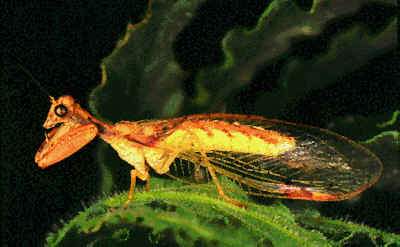
Order
NEUROPTERA(Greek, neuro = nerve; pteron = wing)
Common Names
lacewings, antlions
Description
Lacewings are characterised by their extremely delicate adult stages with large, membranous, finely veined wings from which comes their common name. At rest, the wings are held so that they resemble the sides of a house roof. The antennae are long and composed of short, straight segments (filiform), while the compound eyes are separate and well developed. Mandibles are prominent. Many adult lacewings are insect predators, but some feed on nectar, pollen and honeydew.
Life Cycle
The life cycle is metamorphic with egg, larva, pupa and adult. The pupal stage is always protected by a silk shelter that may be well developed and become a cocoon. Most lacewing species are terrestrial, however there are some species whose larval stages are aquatic in fresh water. The most commonly encountered terrestrial form of lacewing larva is the antlion. These larvae build small, conical pits in dusty or sandy soil and bury themselves at the cone base where they prey upon ants or other insects which stumble into the pits. The mandibles of antlions are modified into pincers so that they are used for both grasping and sucking. The prey is captured, dragged under the soil and its juices are extracted. One common Australian species of lacewing lays its eggs in distinctive groupings: each egg is held at the top of a small thread which is positioned vertically on the substrate and often in a U-shape formation.
Food
Lacewings feed on other insects and small arthropods and are significant insect predators in ecosystems.
Importance
Several species are very important for their control of aphid populations.


